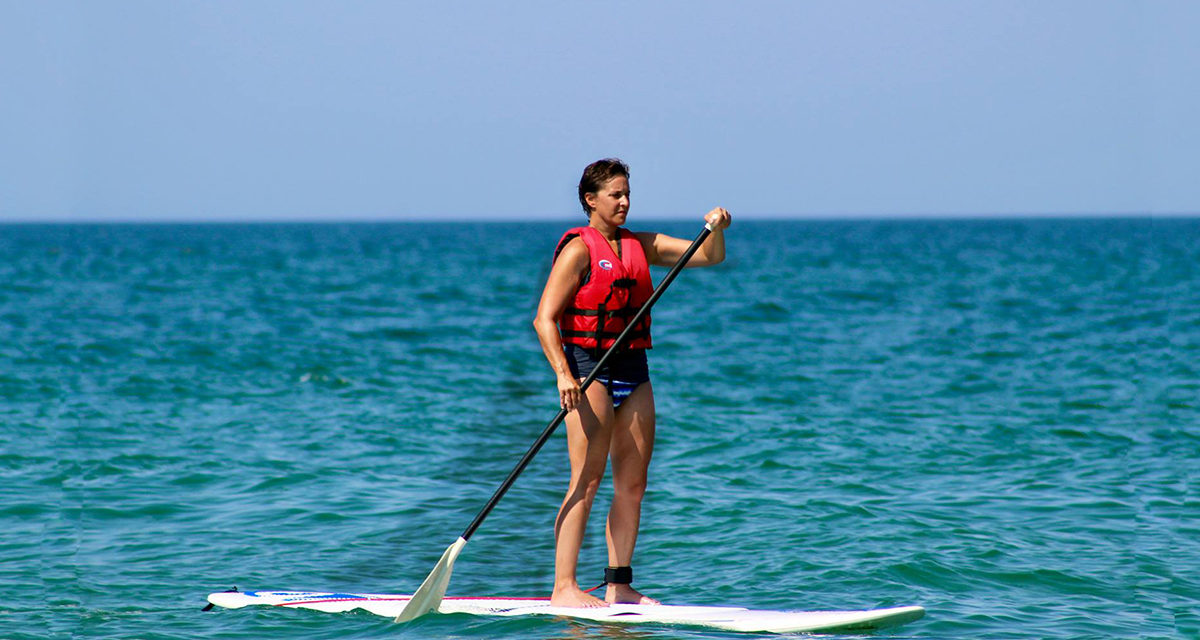On my annual Outer Banks, N.C. vacation with my family, I was feeling adventurous and antsy, so sitting on the beach reading chicklit wasn’t going to cut it this time. So I tried paddleboarding—a summer sport that I’ve had sitting in the margins of my bucket list for a few years—and left the shore feeling healthy, fit, and energized.
If you’re a shore regular, you’ve probably seen these surfboards on steroids hanging off car roofs, especially lately. The paddleboard craze has hit a bit of a frenzy recently, in part because it’s relatively cheap, easy to learn, and it can be done in just about any body of water. My niece and I rented two paddleboards (and paddles) and immediately took them for a test drive in the Currituck Sound. With basically no instruction, we strapped the leashes to our ankles, stepped off the dock onto the boards, and tooled around the bay for an hour or so.
The next day, we ventured out on the ocean, and after about 30 minutes of clumsily falling sideways off my board, I started to get the hang of it and found myself in a state of serenity and joy that I don’t get from running or even my favorite athletic pursuit—spinning. By the end of our vacation, I felt at ease on the board, shifting my weight and maneuvering my body minutely to absorb the waves. I was so focused and in the moment that I apparently missed a handful of dolphins swimming right by me, (but in my defense, it was high tide, and it took all my concentration to stay upright).
But that just gives me an excuse to get back out there this summer—a date with my dolphin friends somewhere on the Atlantic. Here’s what you need to know to try paddleboarding for yourself.
Equipment: If you’re just starting out, you want to select a board that will provide you with the most stability. Unless you’re somewhat seasoned, most women of average height will do best with a 10’6” all-around (or planing) paddleboard. They are ideal for beginners, especially if you plan to paddle on a bay, lake, or calm ocean. You can also check out displacement (or hybrid) boards, which look more like sit-on-top kayaks and provide a bit more versatility in case you want to fish or try surfing.
Heads up: The boards are awkward and somewhat heavy, so it might be a two-person job to get the equipment to your entry point. The Jersey Shore is rich with places to rent paddleboard equipment, and you can usually rent by the week or day, and sometimes even by the hour.
Body Benefits: Core. Core. (And also core.) In addition to testing your balance as you try to combat any waves, you power your paddleboard almost completely with your core, as opposed to your arms or shoulders. When you do it right, you’ll feel the tightness in your tummy afterward, as if you’ve spent the day doing crunches instead of floating on the water. On average, paddleboarding torches more than 500 calories an hour, although it varies depending on whether you’re combating waves or gliding on calmer water.
Words of Wisdom: If you decide to take the paddleboard out to the ocean, make sure you get far enough beyond the break where the water is relatively smooth. It sounds obvious, but it took me half a dozen headers into the water to realize I was too close to the shore. Stand shoulder-width apart, and make sure to keep a slight bend in the knees for shock absorption, especially if you are heading into the ocean or a bay or lake with lots of boat or jet ski action.






